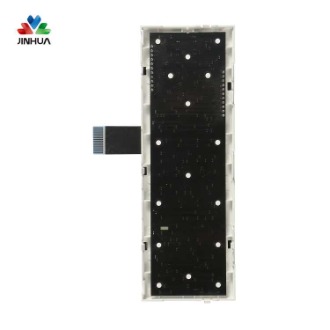ЖК-дисплеи, светодиодные дисплеи и OLED-дисплеи — это три различных типа технологий отображения, которые обычно встречаются в современных электронных устройствах. Хотя оба они используются для вывода изображений и видео, они сильно различаются с точки зрения принципов работы, качества изображения, энергоэффективности и применимости. Ниже приводится подробное, подробное и подробное сравнение ЖК-дисплеев, светодиодных дисплеев и OLED-дисплеев:
1. Принцип работы:
1.1 ЖК-дисплей (жидкокристаллический дисплей): ЖК-дисплей состоит из молекул жидких кристаллов. Жидкий кристалл находится между двумя кусками стекла. На этих очках имеется слой электродов. Когда электрическое поле прикладывается к жидкому кристаллу, молекулы жидкого кристалла вращаются между двумя электродами, меняя полярность света. В зависимости от изменения полярности ЖК-дисплей может управлять передачей и блокировкой света для отображения изображений.
1.2 Светодиодный экран (светодиод, светодиодный экран): Светодиодный экран состоит из множества светодиодов. Светодиод – это полупроводниковый прибор, излучающий свет при прохождении через него тока. В Светодиодный дисплейЭти светодиоды расположены в виде матрицы, и изображение можно отображать, регулируя яркость светодиодов разных цветов.
1.3 OLED-дисплей (органический светоизлучающий диод, дисплей с органическим светодиодом): OLED-дисплей также состоит из светодиодов, но в отличие от светодиодных дисплеев, в OLED-дисплеях используются светодиоды, изготовленные из органических веществ. . Эти органические молекулы излучают свет, когда через них протекает ток, что устраняет необходимость в подсветке. OLED-дисплеи являются самосветящимися, что обеспечивает более высокую контрастность и более глубокий черный цвет.
2. Качество изображения:
2.1 ЖК-дисплей: ЖК-дисплеи обычно имеют более высокое разрешение и могут отображать более подробные изображения. Однако из-за наличия источника фоновой подсветки контрастность ЖК-дисплея относительно низкая, а черный цвет недостаточно глубокий. Кроме того, ЖК-дисплеи страдают от искажений цвета, особенно при широких углах обзора.
2.2 Светодиодный дисплей: Светодиодный дисплей обеспечивает высокую контрастность и яркие цвета. Они превосходят ЖК-дисплеи по качеству черного и обеспечивают более глубокий черный цвет. Кроме того, светодиодные дисплеи имеют более быстрое время отклика и могут хорошо отображать изображения в движущихся сценах с высокой скоростью.
2.3 OLED-дисплей: OLED-дисплей является самосветящимся и обеспечивает настоящий черный цвет и более высокую контрастность. Они более отзывчивы и обеспечивают более плавное изображение. Кроме того, цветопередача OLED-дисплея более яркая и реалистичная при более широком угле обзора.
3. Энергоэффективность:
3.1 ЖК-дисплеи. ЖК-дисплеи относительно энергонеэффективны, поскольку для освещения изображения им требуется внешняя подсветка. Энергопотребление подсветки велико, что приводит к соответствующему увеличению энергопотребления всего дисплея.
3.2 Светодиодный дисплей. Светодиодные дисплеи более энергоэффективны, поскольку каждый светодиод излучает свет только тогда, когда это необходимо для отображения яркости. Они не требуют подсветки и могут регулировать яркость изображения, управляя яркостью разных светодиодов. Такие характеристики дают светодиодным дисплеям преимущество в энергосбережении.
3.3 OLED-дисплеи: OLED-дисплеи относительно энергоэффективны, поскольку они не требуют подсветки и потребляют энергию только тогда, когда им необходимо излучать свет. Их энергосберегающие преимущества более очевидны, чем у светодиодных дисплеев, и они позволяют существенно снизить энергопотребление всего устройства.
4. Применимость:
4.1 ЖК-дисплей: ЖК-дисплей широко используется в телевизорах, компьютерных мониторах, мобильных устройствах и автомобильных навигационных системах. Они имеют высокую степень проникновения и применимости на рынке.
4.2 Светодиодный дисплей. Благодаря высокой яркости и контрастности светодиодный дисплей широко используется на наружных рекламных щитах, сценических площадках, спортивных площадках и в других местах. Кроме того, светодиодные дисплеи также широко используются в рекламных щитах внутри помещений, электронных информационных табло, электронных ценниках и других областях.
4.3 OLED-дисплей: OLED-дисплей в основном используется в высококачественной бытовой электронике, такой как смартфоны, планшеты и телевизоры. Поскольку OLED-дисплеи могут обеспечить более высокую контрастность, большую прозрачность и более тонкий дизайн, потребители предпочитают их.
Подводя итог, можно сказать, что существуют различия в принципах работы, качестве изображения, энергоэффективности и применимости между ЖК-дисплеями, светодиодными дисплеями и OLED-дисплеями. Каждая технология отображения имеет свои преимущества и ограничения. В соответствии с различными требованиями применения мы можем выбрать подходящую технологию отображения, отвечающую нашим потребностям.








 English
English Deutsch
Deutsch русский
русский español
español العربية
العربية



 IPv6 ПОДДЕРЖИВАЕТСЯ СЕТЬЮ
IPv6 ПОДДЕРЖИВАЕТСЯ СЕТЬЮ
